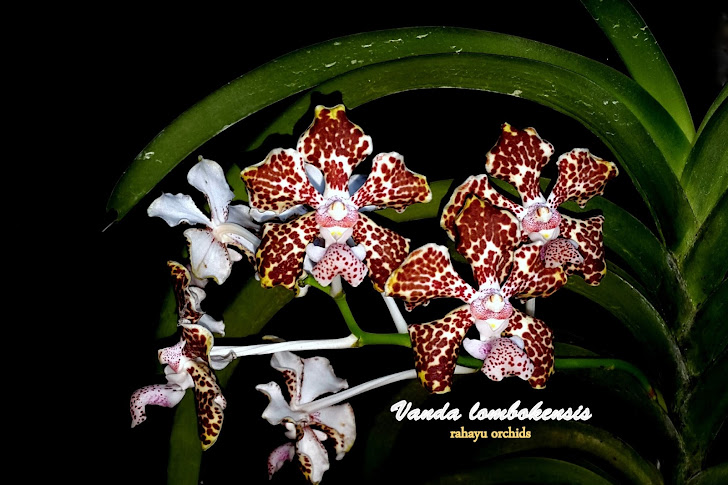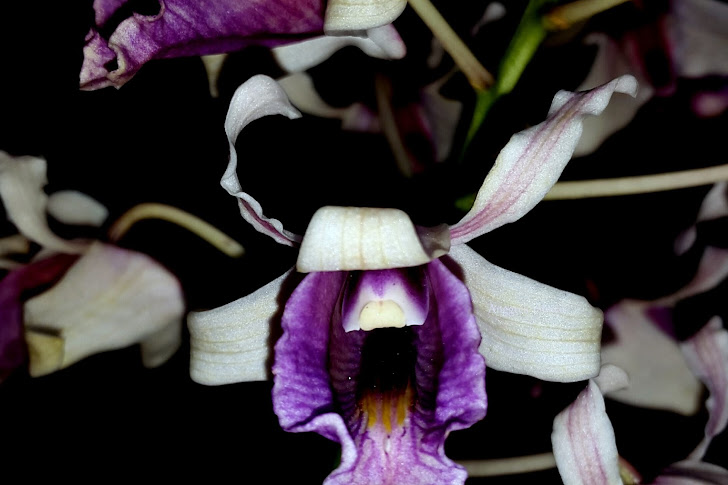? If not, let me introduce you to one of Indonesia’s hidden gems. This exquisite orchid species, found exclusively in the lush landscapes of Lombok, is not just another flower—it’s a symbol of the island's natural beauty and rich biodiversity. With its vibrant colors and unique characteristics,
stands out among the many orchid species that grace our planet. In this article, we’ll take a deep dive into the world of this stunning flower, exploring what makes it so special, where it comes from, and how it’s cherished by locals and plant enthusiasts alike. Ready to uncover the magic of this Lombok-native orchid? Let’s go!
What is Vanda Lombokensis Orchid?
Vanda Lombokensis Orchid is a rare and captivating orchid species native to the island of Lombok, located in Indonesia. Known for its striking appearance, this orchid is a member of the Vanda genus, which is famous for its large, beautiful flowers. However, what sets Vanda Lombokensis apart from other orchids is its distinct characteristics that reflect both the environment it thrives in and the culture surrounding it.
The name itself gives us a clue about its origins. The "Vanda" part refers to the genus, a classification of orchids often admired for their elegant, vibrant blooms. The "Lombokensis" portion of the name ties the plant specifically to Lombok, an island east of Bali known for its rich biodiversity and tropical landscapes.
In terms of appearance, Vanda Lombokensis boasts stunning flowers that are typically smaller but no less dazzling than those of its relatives. The blooms usually feature a deep, rich purple to lavender hue, occasionally with subtle streaks of white or yellow. These delicate flowers grow on long, slender stems and have a distinctive shape that makes them highly recognizable. The leaves of the plant are broad, fleshy, and long, contributing to its overall lush look.
While Vanda Lombokensis shares many traits with other Vanda orchids, it is truly the flower's elegance and rarity that make it so sought after. This orchid isn’t just a botanical wonder—it also holds cultural significance in the region, often regarded as a symbol of natural beauty and resilience. The delicate balance of growing conditions it requires in the wild—along with its status as a rare find—has only increased its allure among orchid collectors and nature lovers alike.
In essence, Vanda Lombokensis is more than just a flower; it’s a living testament to the unique ecosystem of Lombok. If you’re fortunate enough to encounter it in its natural habitat, you’ll quickly understand why this orchid is so special.
Natural Habitat and Distribution of Vanda Lombokensis Orchid
Vanda Lombokensis is found exclusively on the island of Lombok, situated in the West Nusa Tenggara province of Indonesia. This unique orchid species thrives in the island’s tropical climate, where it enjoys the perfect blend of warmth, humidity, and sunlight. The orchid’s natural habitat is typically found in the higher altitudes of Lombok, particularly in the dense forests and on the slopes of the island’s mountains, such as Mount Rinjani.
The orchid grows in a variety of environments within these regions, but it prefers areas with moderate to high humidity and consistent rainfall. The elevation plays a crucial role in the health and blooming of Vanda Lombokensis, as the cooler temperatures found at higher altitudes provide a stable environment for the orchid to thrive. This is one of the reasons why the orchid is so particular about where it grows—only specific ecosystems can sustain its delicate nature.
Vanda Lombokensis is an epiphytic orchid, which means it grows on trees rather than in the soil. It attaches itself to the branches of tall trees using its aerial roots, drawing nutrients and moisture from the air, rain, and surrounding environment. This characteristic allows it to flourish in the wild where the canopy provides shade and protection, while the roots are exposed to just the right amount of air and moisture to keep the plant hydrated.
In terms of distribution, Vanda Lombokensis is relatively localized to Lombok, although there may be isolated occurrences on nearby smaller islands. The orchid is not found in large quantities outside this region, which makes it particularly valuable both to conservationists and orchid enthusiasts. Its specific geographic range is a factor in its vulnerability, as any threats to its habitat could severely impact its population.
The limited range of Vanda Lombokensis has made it an important subject of study for conservationists, who aim to protect both the orchid and the fragile ecosystems in which it resides. Over the years, there have been efforts to preserve its natural habitat, such as creating protected areas where the orchid and other endemic species can continue to grow without the threat of deforestation or illegal harvesting.
In addition, local communities have begun to recognize the importance of preserving this beautiful flower. There is an increasing awareness about the significance of protecting the orchid's habitat, and many conservation initiatives involve collaboration between local governments, environmental organizations, and the people of Lombok.
Overall, the natural habitat and distribution of Vanda Lombokensis are deeply tied to the health of Lombok's forests. Without the right conditions, this magnificent flower could vanish, making conservation efforts all the more critical for ensuring its survival in the wild.
Unique Features and Characteristics of Vanda Lombokensis
One of the most captivating aspects of Vanda Lombokensis orchid is its unique appearance, which sets it apart from other orchid species. While it shares some similarities with other orchids in the Vanda genus, its distinctive features make it a true standout. From its stunning flowers to its growth habits, this orchid has qualities that are admired by botanists, collectors, and nature enthusiasts alike.
1. Striking Blossom Colors
The most notable feature of Vanda Lombokensis is its flowers. These orchids typically bloom in a stunning shade of lavender to deep purple, with subtle variations in color that make each blossom unique. What truly sets it apart are the delicate markings—white or yellow streaks and spots—that can be found on the petals. These patterns often give the flower a vibrant, almost painterly look, making it highly sought after for decorative purposes. The flowers are smaller compared to some other Vanda orchids, but their color and intricate markings more than make up for their size. The petals are slightly ruffled, adding a touch of elegance to the flower’s overall aesthetic.
2. Epiphytic Growth Habit
Like many orchids, Vanda Lombokensis is epiphytic, which means it grows on other plants rather than in the soil. This growth habit is an adaptation to its environment, as it allows the orchid to access better light and air circulation high in the trees. The orchid attaches itself to tree branches using aerial roots, which help it absorb moisture and nutrients from the air. This method of growing also means the plant doesn't need to compete with other plants for space on the forest floor, giving it a better chance to thrive in the wild.
3. Resilient and Adaptable
Despite its delicate appearance, Vanda Lombokensis Orchid is known for being quite resilient. It has adapted to survive in a range of environmental conditions found on Lombok, including fluctuations in temperature and humidity. However, it does require specific care when cultivated outside its native habitat. In the wild, the orchid thrives in the cooler, higher altitudes of Lombok’s forests, where it benefits from the misty mornings and cooler evenings. This resilience makes it an attractive plant for growers, but also means that proper care and the right environment are essential when growing it outside of its natural range.
4. Compact and Elegant Appearance
In comparison to some of its larger relatives, Vanda Lombokensis is more compact, which makes it a perfect addition for both small and large gardens. Its graceful growth pattern—tall, slender stems adorned with elegant clusters of flowers—adds a sense of sophistication to any space. This orchid is not overly showy but has an understated beauty that draws attention through its simplicity and the fine details of its design.
5. Cultural Significance
Beyond its physical attributes, Vanda Lombokensis also holds cultural significance for the people of Lombok. The orchid is considered a symbol of the island’s natural wealth, and it has become an emblem of pride for the local communities. It is sometimes featured in local ceremonies and celebrations, with its vibrant flowers representing the island’s rich flora and the connection between nature and the local culture. The orchid's rare and elusive nature has also made it a subject of local legends, further enhancing its mystique and significance within Lombok’s cultural fabric.
6. Conservation Value
The rarity and beauty of Vanda Lombokensis have also made it an important subject in conservation efforts. Its limited distribution in the wild means that it is highly vulnerable to threats such as habitat destruction and illegal collection. As a result, this orchid has become a focal point for conservation programs aimed at preserving not just the plant itself, but the delicate ecosystems of Lombok that sustain it. Through these efforts, local communities and environmental organizations are working together to ensure the continued existence of this stunning species in the wild.
Care and Cultivation of Vanda Lombokensis Orchids
Caring for and cultivating Vanda Lombokensis Orchid requires some specialized knowledge, but with the right conditions, this beautiful orchid can thrive and bloom year after year. As with many orchids, it’s all about providing the perfect environment that mimics its natural habitat. Here’s a guide to ensure your Vanda Lombokensis receives the care it needs to flourish:
1. Temperature and Humidity
One of the most important aspects of growing Vanda Lombokensis is maintaining the right temperature and humidity. This orchid species is native to the higher altitudes of Lombok, where it enjoys a cooler climate. As a result, it prefers temperatures ranging between 20°C to 28°C (68°F to 82°F) during the day, with cooler nights around 15°C to 22°C (59°F to 72°F). These cooler temperatures mimic the mountain air of its native habitat.
Humidity is also crucial. Vanda Lombokensis Orchid thrives in high humidity, ideally between 60% and 80%. If you're growing it indoors, placing a humidifier nearby or misting the plant regularly can help maintain the right moisture levels in the air. If you're growing it outdoors, ensure that it’s in an area where the humidity is naturally high, such as a shaded garden or near water sources.
2. Light Requirements
Like many orchids, Vanda Lombokensis requires plenty of bright, indirect light to grow well. Direct sunlight can scorch its delicate leaves, so it’s essential to provide filtered light, especially in hot climates. If you're growing it indoors, a spot near a window with sheer curtains or a shaded outdoor area is ideal. A few hours of morning sunlight is usually fine, but avoid intense midday sun.
Inadequate light will lead to weak growth and poor flowering, while too much direct sun can cause the leaves to burn. You can also supplement natural light with grow lights, particularly if you're growing it indoors where natural light might be limited.
3. Watering and Drainage
Watering is one of the trickiest aspects of orchid care, but with Vanda Lombokensis, it’s crucial to get it right. As an epiphytic orchid, it doesn’t require soil but thrives when watered thoroughly so the roots can absorb the moisture.
Water the orchid generously when the growing medium or roots feel dry to the touch, but make sure not to let the plant sit in water, as this can lead to root rot. Vanda Lombokensis requires regular watering, especially during the warmer months, but it’s important to allow the roots to dry out between waterings.
To improve drainage and prevent waterlogging, it’s best to plant the orchid in a well-draining medium such as a mix of bark, sphagnum moss, or even a specialized orchid potting mix. Some growers prefer to mount Vanda Lombokensis on a piece of wood or tree bark, which allows the roots to be exposed to the air and maintain good airflow. Just be sure to water it regularly while ensuring it’s not sitting in stagnant water.
4. Fertilization
To encourage healthy growth and vibrant blooms, fertilization is essential. During the growing season (typically spring and summer), feed your Vanda Lombokensis every two weeks with a balanced orchid fertilizer that is diluted to about one-quarter of the recommended strength. This ensures the plant gets the nutrients it needs without overwhelming it.
In the fall and winter, reduce fertilization as the plant enters a dormant phase. Over-fertilizing during this period can harm the plant or prevent it from blooming. Look for fertilizers that are high in potassium and phosphorus to promote healthy flower development when it’s time to bloom.
5. Air Circulation and Support
Since Vanda Lombokensis is an epiphytic orchid, it thrives in a well-ventilated environment. Good airflow around the plant will prevent issues like fungal growth and rot. If you're growing the plant indoors, make sure the room is adequately ventilated. If outdoors, place the orchid in a location where there is gentle air movement, such as near a fan or open window.
As the orchid grows, it may need support to keep its long, slender stems upright. You can tie the plant gently to a stake or use a vertical support structure to help maintain its shape. This will prevent the plant from becoming top-heavy and ensure that it can direct its energy into blooming rather than struggling to stay upright.
6. Repotting and Mounting
Although Vanda Lombokensis doesn’t require traditional repotting like many orchids, it may need to be mounted or placed in a larger container as it grows. If you choose to mount it, use a piece of driftwood or tree bark that allows the roots to cling onto a surface naturally. This gives the plant a more natural growing environment, mimicking its wild habitat.
If growing it in a pot, make sure it has ample drainage holes to prevent water from sitting at the bottom. Over time, the potting mix can break down, so repot the orchid every 1-2 years or when it becomes overcrowded or the medium starts to decompose. When repotting, try not to disturb the roots too much, as they are sensitive.
7. Pruning and Deadheading
After your Vanda Lombokensis finishes blooming, it’s important to prune the flower spike to promote new growth. Cut the spike back to the base, but be careful not to damage the plant itself. Regular pruning will help the orchid focus its energy on producing new blooms and healthy roots rather than spending energy on old flowers.
Deadheading, or removing spent flowers, is also essential to encourage new blooms and prevent the plant from diverting its energy into developing seed pods. If the flower spike begins to turn brown or shriveled, trim it back to ensure the orchid remains healthy and focused on new growth.
8. Pest and Disease Control
Although Vanda Lombokensis is generally hardy, it can still fall victim to common orchid pests such as mealybugs, scale insects, and aphids. Regularly inspect your orchid for any signs of pests and treat them promptly with organic insecticides or by gently wiping the plant with a damp cloth.
Fungal and bacterial diseases can also pose a threat, especially if the orchid is watered too frequently or if there’s insufficient airflow. Always allow the plant to dry out between waterings, and ensure that it’s not sitting in water or too much moisture for extended periods. If you spot any signs of rot or disease, remove the affected parts immediately to prevent it from spreading.
With the right care and attention to its specific needs, Vanda Lombokensis Orchid can flourish and bring years of beauty and elegance to your garden or home. Although it requires some specialized knowledge, the rewards are well worth the effort, especially when you witness the stunning blooms that this rare orchid can produce.
Threats to the Sustainability of Vanda Lombokensis Orchid
While Vanda Lombokensis is a beautiful and resilient orchid, its existence is increasingly threatened by various factors that jeopardize both its survival in the wild and its continued growth in the broader botanical community. Like many rare and endemic species, Vanda Lombokensis faces several challenges that threaten its delicate balance in the natural world. Addressing these threats is critical to preserving this remarkable orchid and ensuring it can continue to be enjoyed by future generations.
1. Habitat Destruction and Deforestation
One of the most significant threats to Vanda Lombokensis Orchid is the destruction of its natural habitat. As an epiphytic orchid, it relies heavily on the forests of Lombok, particularly the higher elevations near Mount Rinjani, where it thrives in the cooler, misty climate. However, Lombok's forests are under constant pressure from deforestation, driven by agricultural expansion, logging, and infrastructure development. As more land is cleared for farming or human settlements, the orchid's natural environment is being reduced at an alarming rate.
The loss of habitat not only reduces the area available for the orchid to grow but also disrupts the delicate ecosystem that supports it. Without the dense canopy cover and the proper microclimate, Vanda Lombokensis struggles to survive, making it an increasingly rare sight in the wild.
2. Illegal Collection and Trade
Another pressing concern for Vanda Lombokensis is illegal collection and trade. The beauty and rarity of this orchid make it a prized specimen for orchid collectors and traders, both locally and internationally. Unfortunately, in some cases, this has led to overharvesting from the wild, which severely impacts the orchid's population.
Due to its limited distribution and slow growth, Vanda Lombokensis is particularly vulnerable to overexploitation. When too many specimens are removed from the wild, it not only threatens the local population but also disrupts the genetic diversity of the species. This reduces the plant's ability to adapt to changing environmental conditions and increases its vulnerability to disease and climate change.
3. Climate Change
Climate change poses an emerging threat to the survival of Vanda Lombokensis. As global temperatures rise and weather patterns become increasingly unpredictable, the delicate ecosystems of Lombok are undergoing significant shifts. Changes in rainfall patterns, temperature fluctuations, and extreme weather events can alter the orchid's habitat, making it more difficult for the species to thrive.
Vanda Lombokensis is particularly sensitive to changes in temperature and humidity, as these factors directly affect its growth and blooming cycle. If the conditions in its native habitat become unsuitable due to climate change, the orchid may struggle to survive, especially at higher elevations where it traditionally grows.
4. Soil Erosion and Degradation
As deforestation continues, soil erosion and degradation have become significant concerns. The loss of trees and vegetation leaves the soil vulnerable to erosion, which can lead to the depletion of nutrients and the destabilization of the land. This affects not only the orchid's ability to grow but also the entire ecosystem that relies on healthy soil for sustenance. In areas where Vanda Lombokensis grows, this degradation threatens the plant’s root systems, which rely on stable, nutrient-rich environments for optimal health.
5. Lack of Awareness and Conservation Efforts
While efforts are being made to protect Vanda Lombokensis, the lack of widespread awareness about the importance of conserving this unique orchid species remains a challenge. Many local communities and even visitors to Lombok may not fully understand the significance of this rare plant or the threats it faces. Without education and awareness campaigns, there is a risk that the orchid’s delicate habitat will continue to be exploited or destroyed.
Furthermore, although there are some local conservation initiatives, the broader efforts to protect the species are still in their infancy. More resources are needed to create effective conservation programs that involve both local communities and national authorities. These efforts must include habitat protection, education, and legal enforcement to prevent illegal trade and deforestation.
6. Invasive Species
Invasive species are another indirect threat to Vanda Lombokensis. As the balance of ecosystems shifts due to human activities, non-native plants and animals often find their way into new environments. These invasive species can outcompete native flora and fauna for resources, leading to the decline of native species like Vanda Lombokensis.
In particular, invasive plants can crowd out orchids, stealing the sunlight and nutrients they need to grow. Some invasive animals, like herbivores, may also destroy the plant or disrupt its habitat by eating the vegetation around it. This competition and disruption can make it even harder for the orchid to survive in the wild.
Efforts to Protect Vanda Lombokensis Orchid
Despite these significant challenges, there are ongoing efforts to protect Vanda Lombokensis Orchid. Conservationists and local communities are beginning to recognize the importance of safeguarding this unique orchid and the ecosystems it inhabits. Some of these efforts include:
- Habitat Preservation: Creating protected areas and national parks where Vanda Lombokensis and other native species can thrive without the threat of deforestation.
- Regulation and Enforcement: Strengthening laws against illegal harvesting and trade of rare plants, with stricter penalties for those caught exploiting Vanda Lombokensis from the wild.
- Sustainable Cultivation: Encouraging local farmers and orchid enthusiasts to cultivate Vanda Lombokensis in controlled environments, reducing the need to harvest wild plants.
- Public Education: Raising awareness about the importance of preserving this orchid and its habitat, both among the local population and internationally, to ensure long-term conservation success.
Through these concerted efforts, there is hope that Vanda Lombokensis Orchid can be preserved for future generations. However, much work remains to be done to ensure that this beautiful and rare orchid continues to thrive in its natural habitat.
























